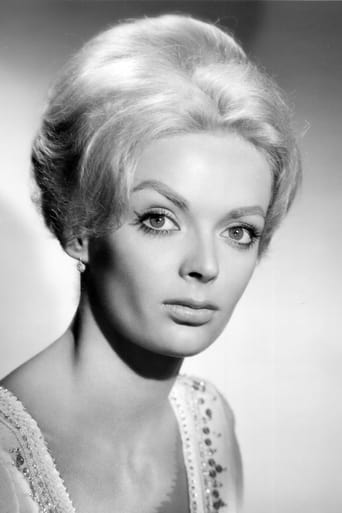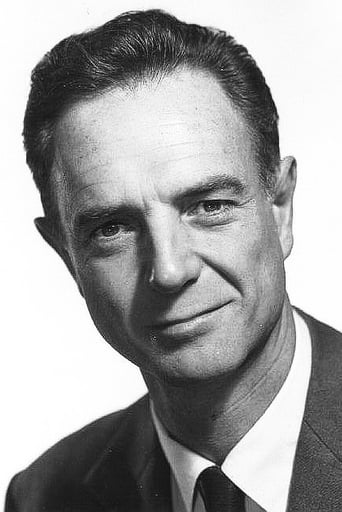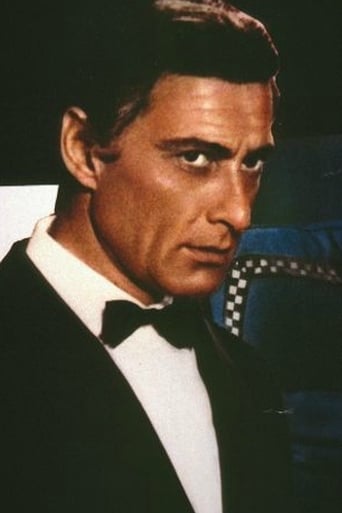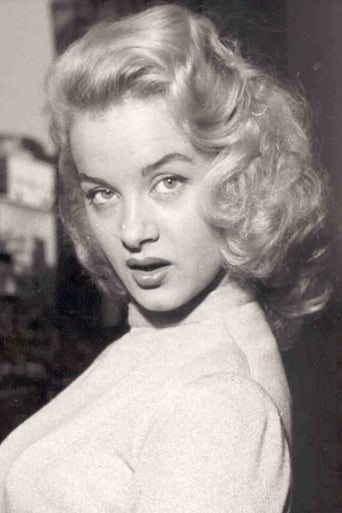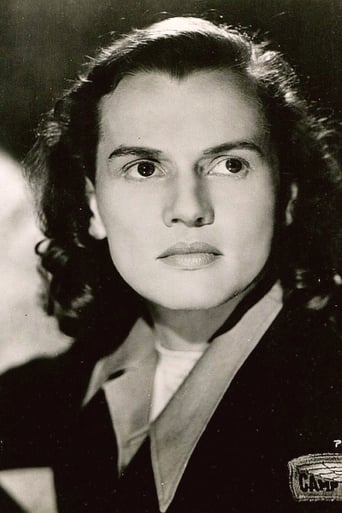Scott LeBrun
Robert Flemyng is the title character, Dr. Bernard Hichcock, a doctor / surgeon in 19th century London. His wife Margaret (Maria Teresa Vianello) dies under suspicious circumstances, and years later, Bernard marries younger woman Cynthia (a radiant Barbara Steele). She begins to see and hear strange things, and one of the questions that the story asks is whether Cynthias' visions are real or imagined. Certainly Cynthia starts to suspect her husband of something sinister. Bernards' colleague Dr. Kurt Lowe (Silvano Tranquilli) cares for her and starts wondering about Bernard himself.Written by Ernesto Gastaldi, and directed by Mario Bavas' mentor Riccardo Freda, "The Horrible Dr. Hichcock" is fairly engrossing as a mystery, with the two of them being as vague as possible as to what Bernards' intentions are. All we know that is Bernard has a particular kink as part of his personality; this viewer won't mention it here. That helps to give a bit of a lift to what is ultimately a pretty routine story. But the story isn't the principal attraction. It's Fredas' stylized presentation, and the performances of the cast. This is a handsomely produced, suspenseful, atmospheric film, enhanced by a good soundtrack by Roman Vlad. Freda downplays elements such as sex and gore, making his film of more interest to more traditional genre lovers. It's also well paced, clocking in at a mere 77 minutes. (There is a longer, international cut running about 11 minutes longer.)Flemyng is effective in his subtlety when it comes to his villainy. You're not quite sure what to make of him. Tranquilli is an utter stiff, but Vianello is fine as the wife, and American actress Harriet Medin, a familiar face in Italian genre cinema during this time, also comes off well as the loyal maid. Still, "The Horrible Dr. Hichcock" truly belongs to the lovely young Ms. Steele, who's got some of the most expressive eyes one will ever see. We've seen her score in villainous roles herself, and here she shows that she can also be a sympathetic heroine.Not really a great film in this viewers' humble opinion, but it still provides fine entertainment for any fan of Italian horror.Followed by "The Ghost".Six out of 10.
Scarecrow-88
A master surgeon, one of—if not the best—in the world, has a depraved secret. Riccardo Freda's THE HORRIBLE DR. HICHCOCK is a Gothic horror delight set in London. A beautiful pianist, Margaretha, who is ill, Hichcock's beloved, dies after his anesthetic, used on patients, accidentally kills her.Hichcock must leave his manor because Margaretha's memory torments him, resigning from the hospital and in doing so the doctor meets a new love, Cynthia (horror iconess, Barbara Steele), returning to home and job shortly afterward. As a popular surgeon and doctor, with a distinguished reputation of success, Hichcock is always in demand and so his career often keeps him away from Cynthia who is uncomfortable in the manor. Hichcock, though, after losing Margaretha, will not use the anethstesia any longer as a physician, and this decision increases the mortality rate of the patients under his care, earning disappointment and criticism from those who work alongside him. Meanwhile, Margaretha's memory, all her portraits enshrined throughout the manor, walls and walls adoring her beauty, becomes a burden to Cynthia who just wants to have one room that doesn't remind her of love lost. Through Bernard, we learn that Cynthia was in a hospital due to a terrible mental shock as a result of her father's death, establishing a potential psychological problem which might be contributing to several eerie instances where she hears voices forewarning her of death to come, not to mention, footsteps, a turning doorknob, and a skull found on her bed. Hichcock does have a suspicious maidservant, Martha, who shows her disapproval when Bernard is in her presence, and doesn't hide her disgust for Cynthia or the sheer fact that he has "replaced" Margaretha with another. A locked room Martha is protective of intrigues Cynthia—what is in this room? Another subplot concerns Bernard's assistant, Curd, who falls in love with Cynthia, his feelings quite evident when they are alone together; it creates the obvious awkwardness because both know these feelings exist. As time goes by, Hichcock becomes more and more distant and cold, which certainly affects his marital relations with Cynthia.Truthfully THE HORRIBLE SECRET OF DR. HICHCOCK is as much a dark, Gothic soap opera as it is a horror movie with all the elements in place, in particular, the result of Bernard's infatuation with the corpse of a lovely woman at his hospital and how his alienation for Cynthia slowly drives a wedge between their marriage (and, it is certain to drive her into the arms of Curd who would offer her more of a fruitful relationship).What is interesting (or at least what *I* found interesting) is that not only does Hichcock have a secret, but Martha is hiding something as well. The room with the mirror, Hichcock's old laboratory, holds that secret Martha has been intent on keeping to herself, and soon Bernard—as does Cynthia through investigation (or, as one might call plain, old snooping)—will experience himself what she has been hiding. I think this is when the movie hits its stride, near the hour mark, with what I consider the film's greatest set piece, during a loud thunderstorm, the lightning bright and powerful, where Bernard hears a familiar tune from the piano in his manor, someone in a white dress, face covered by a veil, which initiates his long dormant perversion to flower, poor Cynthia the victim of his deviant uprising. He will use his anesthesia to paralyze Cynthia, so that she resembles a corpse, unable to move, in order to satiate his deep rooted psycho-sexual deviance. I loved how the movie unravels, the knowledge that Cynthia is in danger because we are allowed to have moments with Hichcock and see the undercurrent of depravity lurking underneath, only a matter of time before his Hyde surfaces. The sinister atmosphere director Ricardo Freda builds is methodical, a slow-burn approach known during this period in Gothic horror when pacing isn't a factor European filmmakers were concerned with.What I love about Barbara Steele is that she can slide into the heroine and villainess roles, ably talented to convince in performance as a victim-to-be, vengeful ghoul, or manipulative menace. Her period in Italy and Europe yielded good and bad, but when you have both PIT & THE PENDULUM and BLACK Sunday on your resume, I'd say that constitutes a solid career, even if it lasted a period of ten years. There is a great scene right out of Von Dreyer's VAMPYR where Cynthia awakens to find herself trapped in a coffin with her inscription written on the outside.. Freda's camera steadily drawing near the casket where a small window (some coffins were made to show the deceased's face prior to burial) to unveil Steele's face, her eyes opening, all that horror being buried alive present, Cynthia's fate grim. Following this is an intense conclusion where Cynthia attempts to escape from what could be Margaretha's specter—Hichcock's home has underground tunnels, prisons, and a crypt, identifiable to Gothic horror films featuring castles, there always seems to be secret passageways and architectural labyrinths to discover by unfamiliars who walk unknowingly into them. The ending is closer to Corman than Bava, however, the burning castle and handsome hero coming to save the damsel in distress. Robert Flemyng I thought was excellent, the way his hands caress the bodies of those he craves to ravage (mostly bodies of the dead!), and how he shows the teeming unrest and disquiet that lies beneath; I think he's a tortured soul who cannot help himself. Silvano Tranquilli has the uninteresting part of bland love interest for Steele..these are the parts that are written without the vitality normally dedicated to the more colorful villain as evident in Corman's Poe films with Vincent Price.
MARIO GAUCI
Actually what I have on VHS (recorded off the TV) is the full-length version of the film, released in the U.K. as THE TERROR OF DR. HICHCOCK (in the U.S. it was cut by 10 mins. and retitled). From the little I have watched of 'Euro Horror', this is definitely one of the highlights; most critics place it at the top of Freda's canon and it's easy to see why. Visually the film is stunning (even if the print I have watched has seen better days) with any number of striking images that are not easily forgotten.Still, the film's greatest coup, perhaps, is its unabashed (but not sensationalistic) treatment of necrophilia, a theme that was pretty much taboo at the time - and probably still is! (I urge you all to read Glenn M. Erickson's excellent and highly perceptive essay on the film on the 'Images Journal' website - incidentally, you will find a whole section here devoted to Italian horror films.) In this respect, THE TERROR OF DR. HICHCOCK would make a fine companion piece to Mario Bava's LA FRUSTA E IL CORPO/THE WHIP AND THE BODY (1963), another unhinged (and extremely personal) Gothic masterwork!The exemplary cast is headed by Barbara Steele and Robert Flemyng. Steele is pretty good in what she has to do (though never quite scaling the heights of LA MASCHERA DEL DEMONIO/THE MASK OF Satan [1960]) but is overshadowed by Flemyng as Dr. Bernard Hichcock (an inspired choice for a name!) who is utterly credible in all the various facets of manic lust his character has to go through. Indeed, this doctor would not have been amiss in a Poe story and, much as I love Vincent Price in the AIP/Corman adaptations, Flemyng here emerges a far more sinister figure - without ever resorting to camp!Finally, I wonder how this film's follow-up LO SPETTRO/THE GHOST (1963), which I have never watched, compares with the original. Hopefully both films will one day be adequately represented on DVD, possibly released as a double-feature.
zmaturin
In this movie Dr. Hitchcock develops a particularly effective anesthetic. Of course, it he wanted to put people to sleep he could have just shown them this movie! Woo-Hoo! Take that, "The Horrible Dr. Hitchcock"!Seriously, though, I never thought a movie starring Barbara Steele about necrophilia and people being buried alive would be so boring. Dr. Hitchcock resembles a wormy James Caan and makes goofy faces whenever aroused- that is, when he's not being played by an obvious stunt double. Barbara sports some painful looking fake eye-lashes and has a sort-of romantic relationship with a guy even blander than Dr. H. About halfway through this flick you can leave, make yourself a salad, read a book, do some light cleaning and come back and not miss anything. This makes "The Screaming Skull" look like "Psycho".


